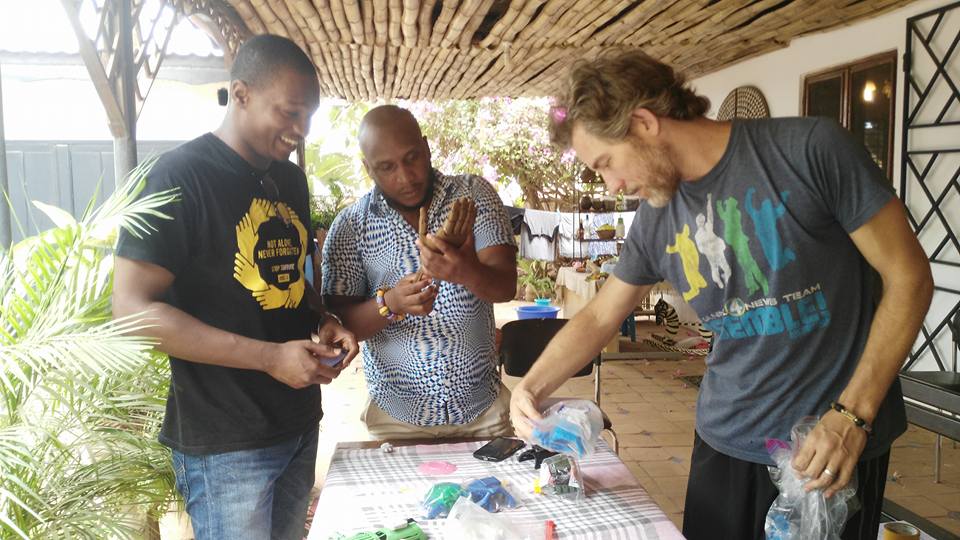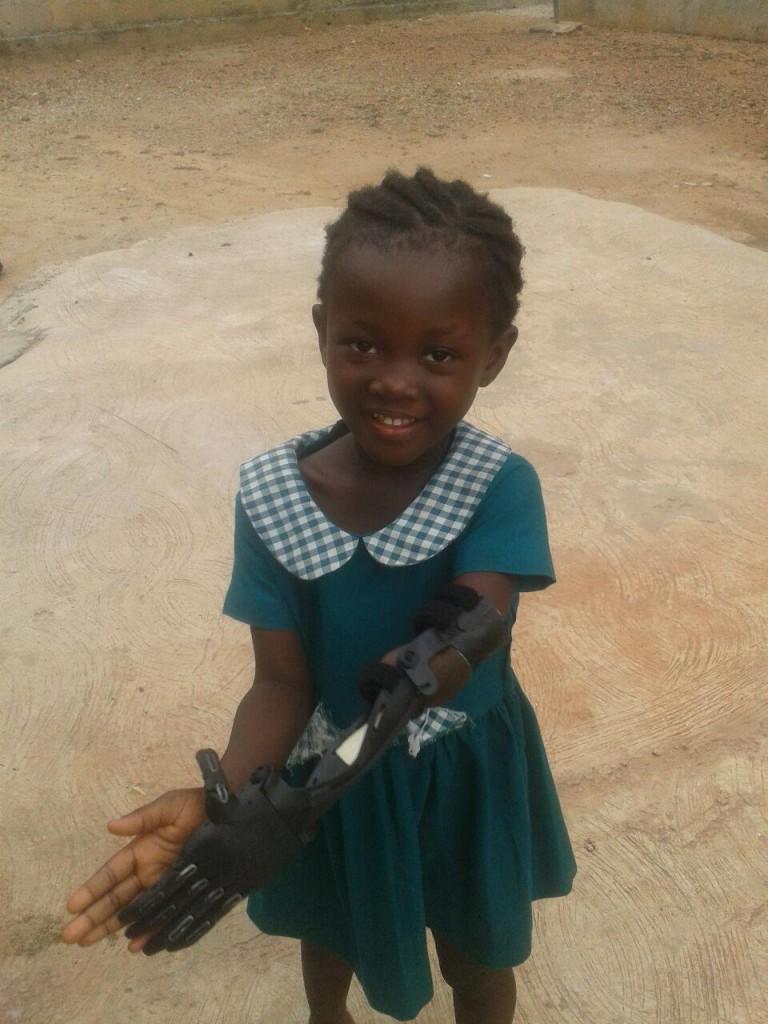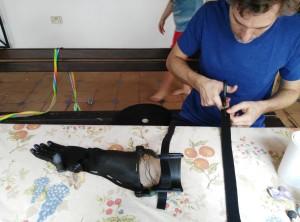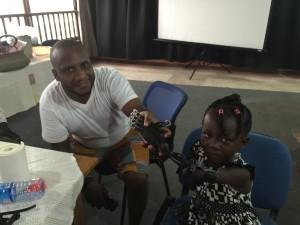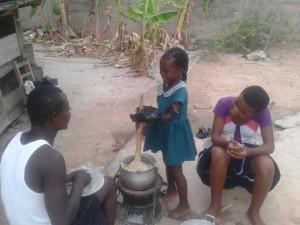 Sometimes a small act of kindness can lead to unexpected benefits for both the recipient and the good Samaritan, and can change their lives forever. When I was barely a teen, my family took in a Ghanaian teenager, who used to babysit me and my little brother, when he had no place else to go. What was thought to be a temporary solution ended up becoming a permanent bond. I gained an older brother and I have benefitted from his insight and guidance over the years. Through my brother, Yaw, I became deeply interested in African affairs, and especially invested in news about Ghana and war-torn Liberia. When I learned about the work of e-NABLE Ghana, I knew that this was a story I had to cover.
Sometimes a small act of kindness can lead to unexpected benefits for both the recipient and the good Samaritan, and can change their lives forever. When I was barely a teen, my family took in a Ghanaian teenager, who used to babysit me and my little brother, when he had no place else to go. What was thought to be a temporary solution ended up becoming a permanent bond. I gained an older brother and I have benefitted from his insight and guidance over the years. Through my brother, Yaw, I became deeply interested in African affairs, and especially invested in news about Ghana and war-torn Liberia. When I learned about the work of e-NABLE Ghana, I knew that this was a story I had to cover.
We’ve written a lot about the good work of e-NABLE, a network of volunteer 3D printing enthusiasts that provide 3D printed hands free of charge to people with missing fingers, hands or partial lower limb loss. Amanda Cross wrote a blog post about the formation of the e-NABLE Ghana chapter and how its members are changing amputees’ lives for the better. Her husband, Joe Cross, started the e-NABLE Hungary chapter in November 2014. The chapter quickly grew to over 20 volunteers and led to a strategic partnership with Stratasys. The chapter model proved to be very successful and Cross teamed with e-NABLE volunteer Joseph Fairley to create the e-NABLE Chapters team.
The work of e-NABLE Hungary did not go unnoticed. Hungarian-Ghanaian musician Sena Dagadu, who has a Ghanaian family member with a limb injury, wondered if the e-NABLE model would work in Ghana. Dagadu could imagine how 3D printing prosthetics could benefit Ghanaian.
Inspired by Dagadu’s vision, Cross sought out the sole Ghanaian e-NABLE member, Ishmael Afful, to discuss creating a Ghana e-NABLE chapter. Afful had experience working with non-profits and was eager to help.“Wouldn’t it be cool if people in Ghana could see this kind of technology,” says Dagadu. “(Imagine) the prospect of opening people’s eyes, not just to what was possible with 3D printing, but how it could positively impact people with limb differences.”
“One evening I had seen a news report on 3D printing, I spent the night researching and reading about it online, and when I came across e-NABLE, I thought, this is something useful to do with the technology,” says Afful.
Cross, Dagadu and Afful joined forces to found e-NABLE Ghana, and since there were no 3D printers in Ghana, it was up to e-NABLE Hungary to print the prosthetics and bring them to Ghana. As word of the project spread, other e-NABLE volunteers donated, got involved and starting sending hands from all around the world. In all, Cross brought 40 3D printed hands to Ghana. Dagadu used her media contacts to spread the word, to find volunteers and develop partnerships.
Workshops were held to introduce the 3D printed prosthetics to potential recipients and their families. Over 50 people attended the meeting and measurements were taken for future recipients. The organizers noted that the demographics of their potential recipients differed greatly from those of Hungary and other European nations, with most prosthetic hands going to children in those countries. At the e-NABLE Ghana meeting 90% of the attendees were adults and 90% of them were in need of a prosthetic. They also weren’t interested in scifi-based designs; they wanted hands to look as natural as possible, in both color and design.
While there were primarily adults in attendance at the meeting, there was a 5-year-old girl named Lordina who was in need of a lower arm. She was selected to get an on-the-spot fitting. Lordina’s family was educated in the mission of e-NABLE and the technology employed to produce the prosthetics, so the family could feel comfortable with committing to a 4-hour journey to the e-NABLE Ghana workshop. There is a social stigma attached to those who have limb differences, and the family wasn’t sure if a prosthetic would be a good thing for the young girl. Furthermore, they were astounded that the arm would be provided free of charge.
It only took 10 minutes of practice for Lordina to learn how to use her new prosthetic. Her family later reported the Lordina was using the hand at home, but they weren’t letting her wear it to school. Lordina is talking to her classmates about her new arm and the family will need more convincing before they feel comfortable with her wearing the arm in public.
- Joe Cross with volunteers and e-NABLE hand recipient.
- 40 3D printed arms arrive at e-NABLE Ghana.
- Joe Cross preparing a prosthetic.
- Joe Cross fitting an arm on a recipient.
- Lordina getting her e-NABLE arm.
- Lordina using her e-NABLE arm.
- Lordina using her e-NABLE arm.
There’s a lot more that needs to be done to address the cultural barriers that stand in the way of widespread adoption of this technology in Ghana. The members of e-NABLE Ghana are rising to the challenge, but they need more help. The group is in need of 3D printers and donations of filament. If you’d like to donate or get involved with their work, you can contact e-NABLE Ghana at enablinghana@gmail.com. If you’re interested in starting your own e-NABLE chapter, please contact enablechapters@gmail.com.
e-NABLE Ghana has also posted a Wish List of equipment and supplies on Amazon and an Indiegogo campaign for donations. If the work of e-NABLE Ghana has inspired you, please lend a helping hand. Your small act of kindness will change lives for the better, including your own.
Subscribe to Our Email Newsletter
Stay up-to-date on all the latest news from the 3D printing industry and receive information and offers from third party vendors.
You May Also Like
Precision at the Microscale: UK Researchers Advance Medical Devices with BMF’s 3D Printing Tech
University of Nottingham researchers are using Boston Micro Fabrication‘s (BMF) 3D printing technology to develop medical devices that improve compatibility with human tissue. Funded by a UK grant, this project...
3D Printing Webinar and Event Roundup: April 21, 2024
It’s another busy week of webinars and events, starting with Hannover Messe in Germany and continuing with Metalcasting Congress, Chinaplas, TechBlick’s Innovation Festival, and more. Stratasys continues its advanced training...
3D Printing Webinar and Event Roundup: March 17, 2024
It’s another busy week of webinars and events, including SALMED 2024 and AM Forum in Berlin. Stratasys continues its in-person training and is offering two webinars, ASTM is holding a...
3D Printed Micro Antenna is 15% Smaller and 6X Lighter
Horizon Microtechnologies has achieved success in creating a high-frequency D-Band horn antenna through micro 3D printing. However, this achievement did not rely solely on 3D printing; it involved a combination...


